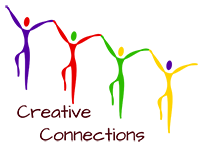Spanish Lesson Plan
Scheme of Work: Local and global views
Recommended Age Group: 11-12
Timescale: 8-12 hours (over 6-8 weeks)
Country: Spain
Project School: Dovella School
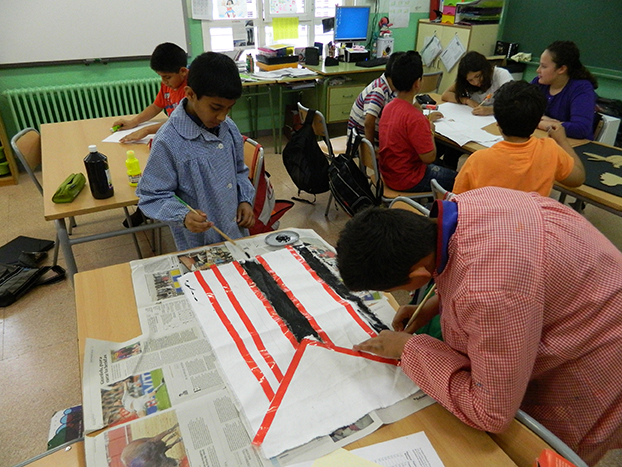
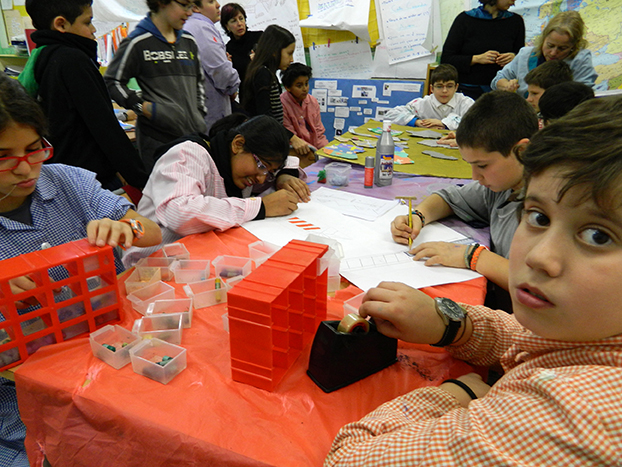
Working processes: 6th grade Dovella School
Conceptual Framework
Using examples of European contemporary art that relate to the concept of citizenship, the following question was explored: What do we know of Europe? In these lessons pupils generated artworks, which facilitated the development of a social critique of their reality. They learned to share it on the web platform provided by the project. This allowed the young people involved to deepen their understanding of citizenship and to move between the local and the global areas.
The following lesson plans correspond to two consecutive activities, developed in school. The first activity is the production of a European image, representing what we understand by the concept of ‘Europe’ today as it relates to the lives of young people.
The second activity corresponds to the production of a work of contemporary art, using the database of European artists of the Creative Connections project as reference, which helped pupils to understand using art as a tool, to give a criticality to their sense of reality and identity.
The activities were developed according to the interests of the group and in constant conversation with the teacher. This meant that the project was conducted with integrity and as part of the dynamics of the group, thereby maintaining an action research methodology within a pedagogical framework of inquiry.
Instructions for Activities
Keywords
- Europe,
- Local view point,
- Global view point,
- Citizenship,
- European Contemporary Art,
- Criticise reality
Lesson 1 Introduction of Creative Connections Project to the Class
Time frame: 1 hour
Resources
Computer and internet access
Explain what the project consists of to the pupils. Let them know who will be involved and with which schools they are going to communicate. Show the website and how the web page works.
Show the Connected Gallery and demonstrate how to up-load images and texts.
Introduce the European context and develop debate and discussion in the first instance, in order to gauge the pupils’ initial thoughts and feelings.
Lesson 2 Activity 1: Our image of Europe
Time frame: 2 hours
Resources
- Computer and internet access
- Drawing/ writing materials
- Paper of different sizes
- Magazines and collage materials
- Glue and scissors
Objectives
- To reflect on what Europe means personally, and as a nation
- To contextualise the idea of Europe in a global way
Start the session with a whole class discussion on ‘What does Europe mean to me?’ Then split the pupils into groups to extend this discussion: What do they understand of Europe? Ask them to create mind maps with their ideas. Pupils might have access to the Internet to research for information for this activity
Possible responses might include:
- Geographical perspectives,
- Travelling in Europe or places they would like to travel,
- Stereotypical views of different European countries,
- Historical perspectives,
- Political aspects.
Pupils create a project folder and document their work.
Ask pupils to create an individual image of Europe: Pupils should be encouraged to develop ideas and concepts from previous discussions and create an image that extends beyond simply using a map. Encourage them, for example, to add details or found images and text to express a personal response. Collage or drawing is a recommended medium for this activity.
Review the work with the whole class
Lesson 2
Time frame: 1-2 hours
Resources
- Computer and internet access
- Drawing and writing materials
- Paper
Objective
- To develop conceptual knowledge and understanding of citizenship themes
- To encourage a democratic model of working in groups
Review work from last session
Ask how each of the issues raised on Europe affect them in their daily lives and ask each pupil to write what they think about it on paper, or make an explanatory drawing of how they personally connect to issues previously raised.
Create a group image of their perceptions of Europe.
Encourage pupils to collaborate by sharing their ideas and making democratic decisions about what should be included. Positive and negative aspects could be explored by making statement.
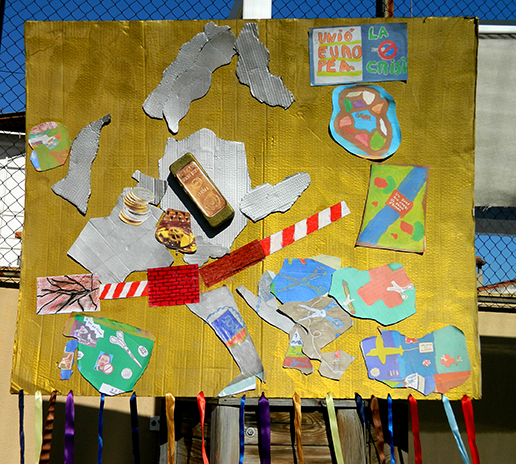
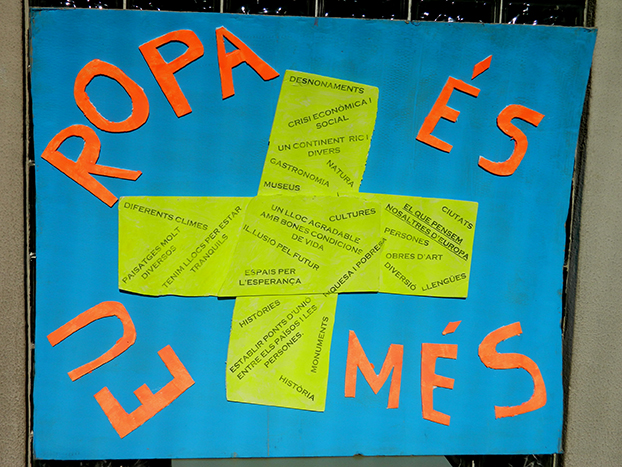
First Image: “European Crisis”. Second Image: “Europe is more“
Lesson 3 Using the Connected Gallery
Time frame: 2 to 3 hours
(This time frame might need to be extended depending on the length of time of artwork production)
Resources
- Access to computers and the Internet
- Paper and drawing / writing materials
- Variety of art resources and materials should be available for group projects.
Objectives
- To understand the critical sense of some contemporary art,
- To learn new media of artistic production,
- To Allow students to express, from their artistic production, their own critics of their reality,
- To be able to explore the connection that each student has with the concepts concerning the Citizenship through the artistic experience,
- To share their works on the website of the CC project with other European children.
Activities
Explain to the pupils how the Art Database is structured and show them a selection of artists from each category (if possible).
Select artworks from the database for discussion. Ask pupils to choose one, or some, that they are especially interested in.
Ask pupils to look for further information of these artists, as homework or in school, to expand knowledge of those who were of each individual’s particular interest. For example, by researching websites of artists to see their collections and to learn more from their biographies.
Pupils work in small groups to create ideas for their own artwork. They should work together to make a short presentation, or explanation, to the rest of the class of the reasons behind their ideas and ask for further suggestions from their peers.
Each group reviews their initial idea for group artwork and incorporates ideas/ materials / techniques/ style from their understanding of the selected artist’s work. They might wish to incorporate suggestions from their peers at this point.
Production of artwork: The teacher might need to demonstrate materials, techniques and skills, and work with groups to facilitate outcomes during this time. Pupils should be encouraged to use materials that are especially coherent with the idea that they want to show.
Each group presents their final work to the class for critical evaluation. They should be encouraged to talk about the process they have experienced, and say what they have learned throughout the project.
As an option, they could organize a small exhibition or share the images in a web site
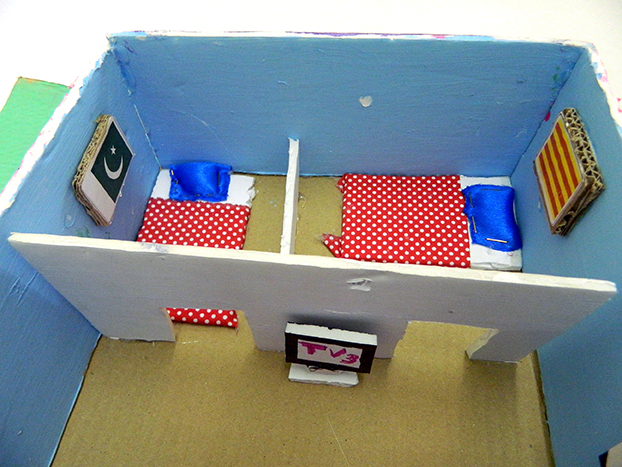
.jpg)
First Image: “Live Together” by Sahar and Aina / Second Image: “A world in Denunciation” by Albert

“Seven Planets” By Noé and Edward
Note on the use of the Connected Gallery:
In this final activity, the use of the Connected Gallery should be left as an option open to pupils to use at will, because the students will have more freedom to create their own works. The idea is that it shouldn't be a strict relationship, so they could tend more towards dialogue with the artist and the meaning of their works instead of trying to copy them. In this way students can be inspired to talk about their own reality in a critical way.
Note for teachers
One of the greatest achievements in the Creative Connections project was that not only for Dovella School but also for all Catalan schools participating in the project, to find that art has the potential to be a vehicle to express a more critical sense of society. It gave pupils the tools to empower them and to discuss their realities with others. To accomplish this was not easy, because the pupils had to break many barriers of the obvious or literal, and had to go beyond a mere aesthetic judgment (I like, I don´t like) to find and produce one single work that showed a concentration of multiple meanings.
